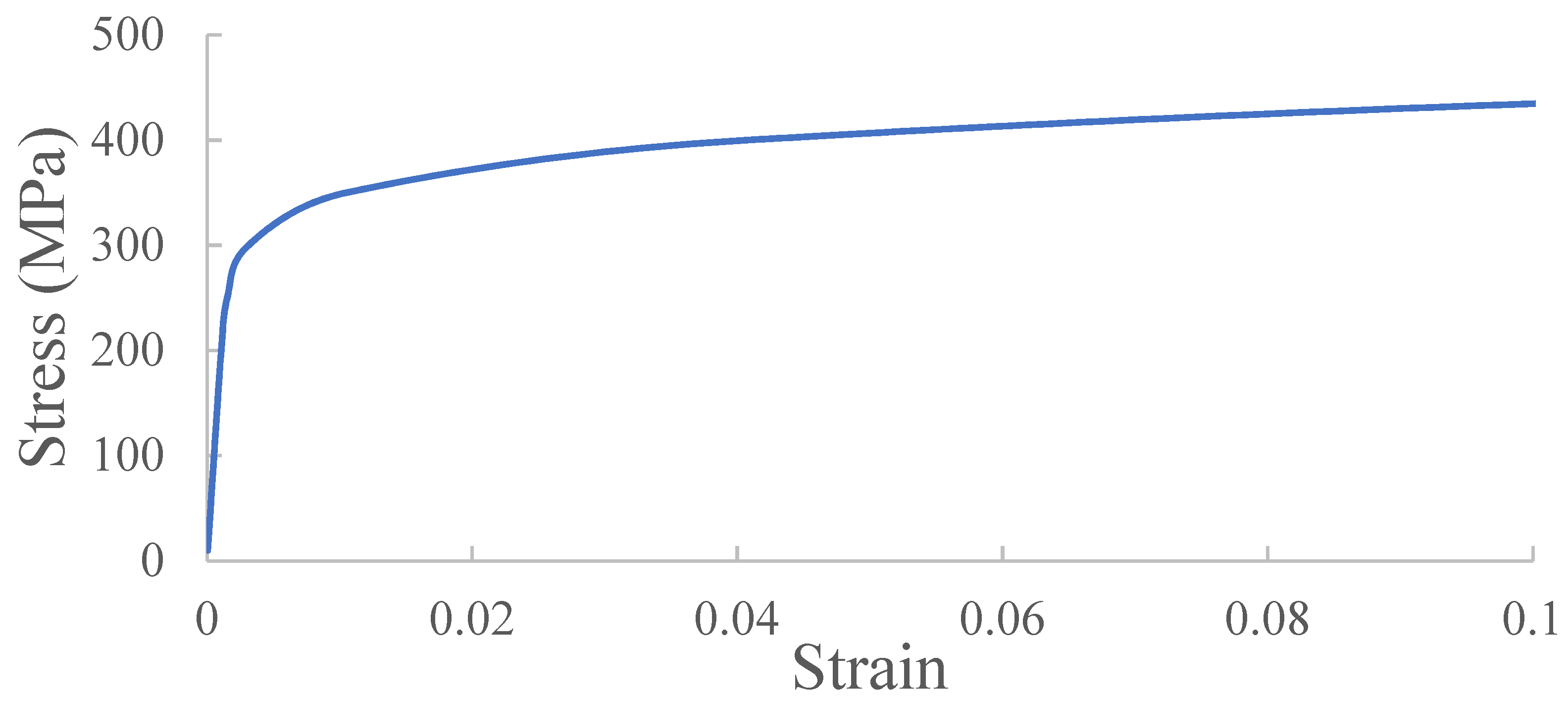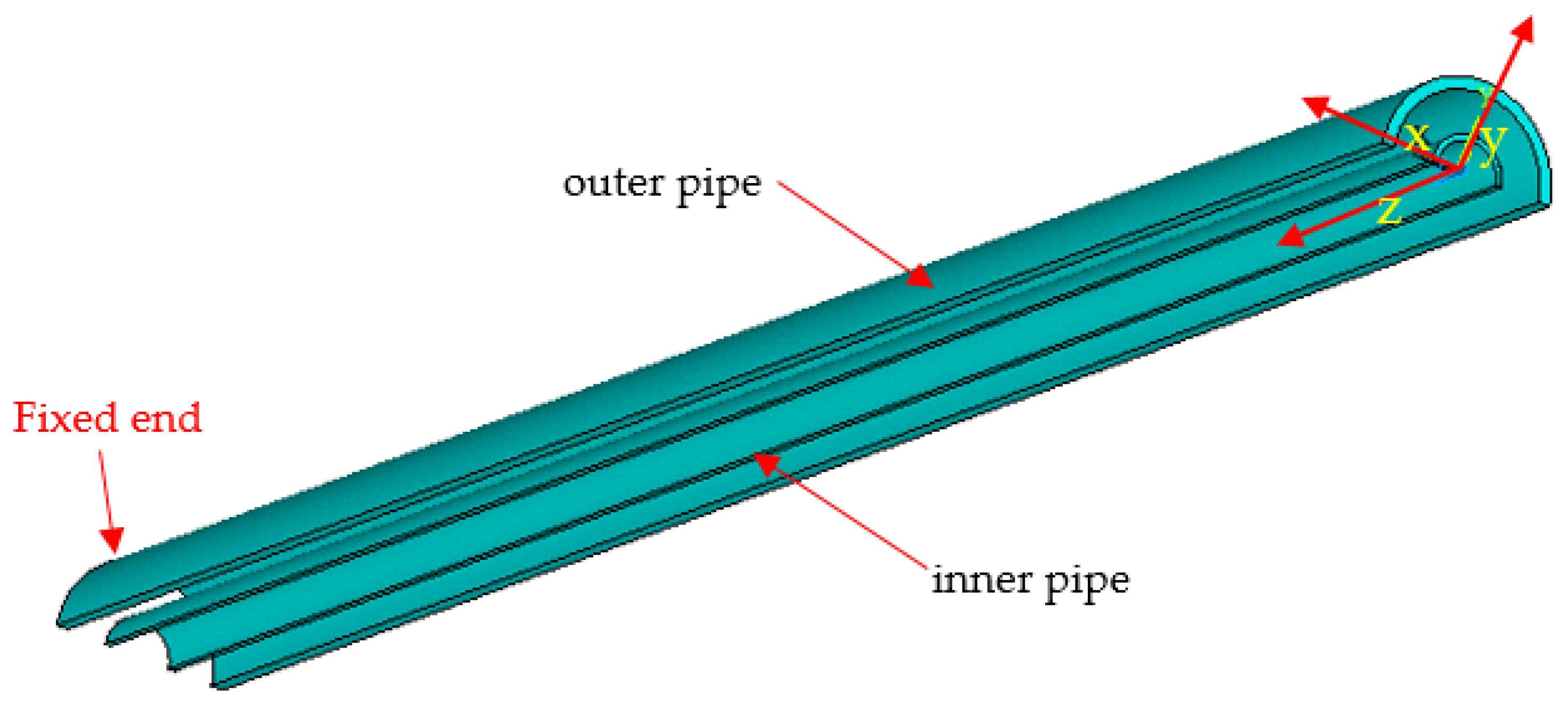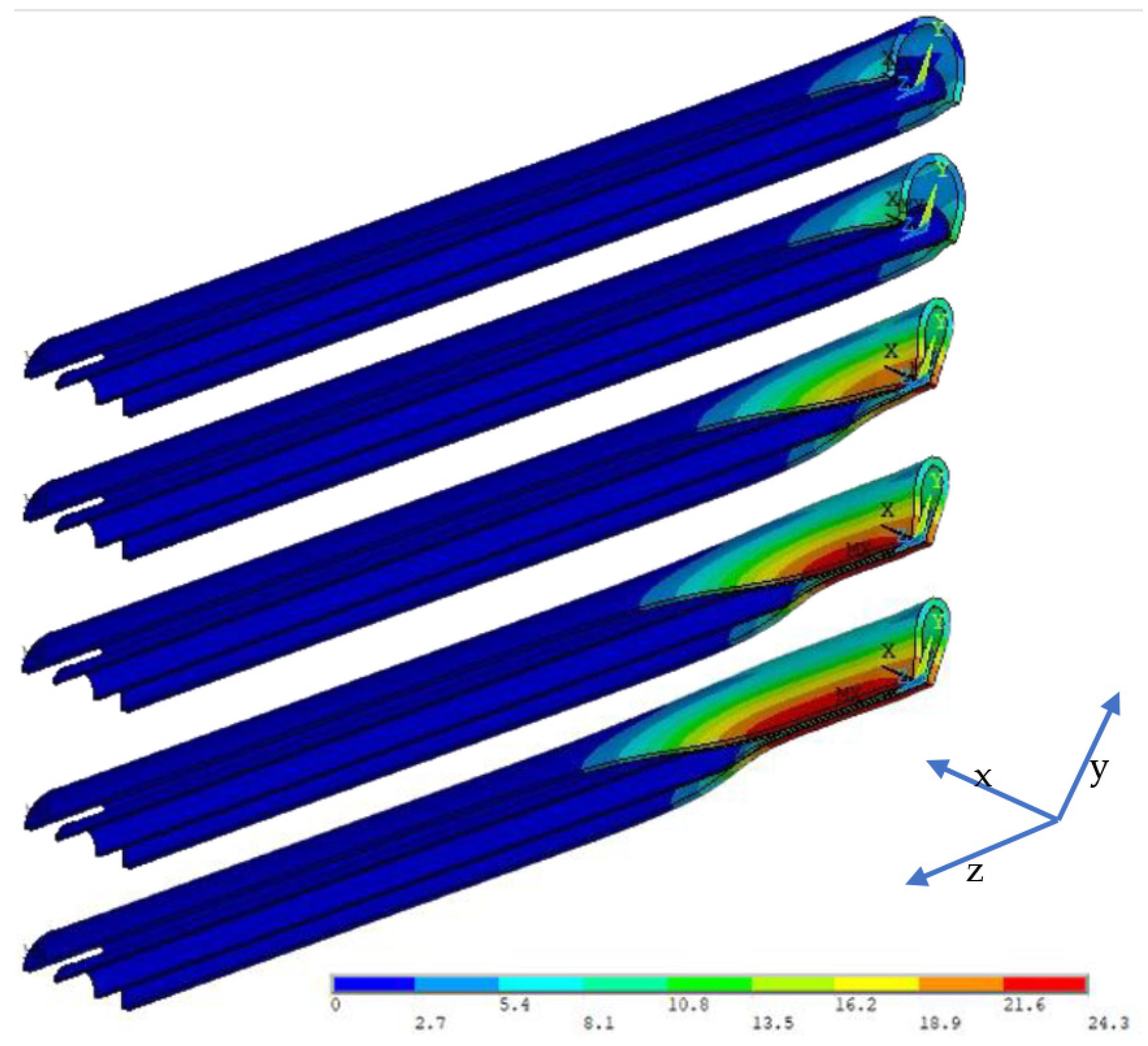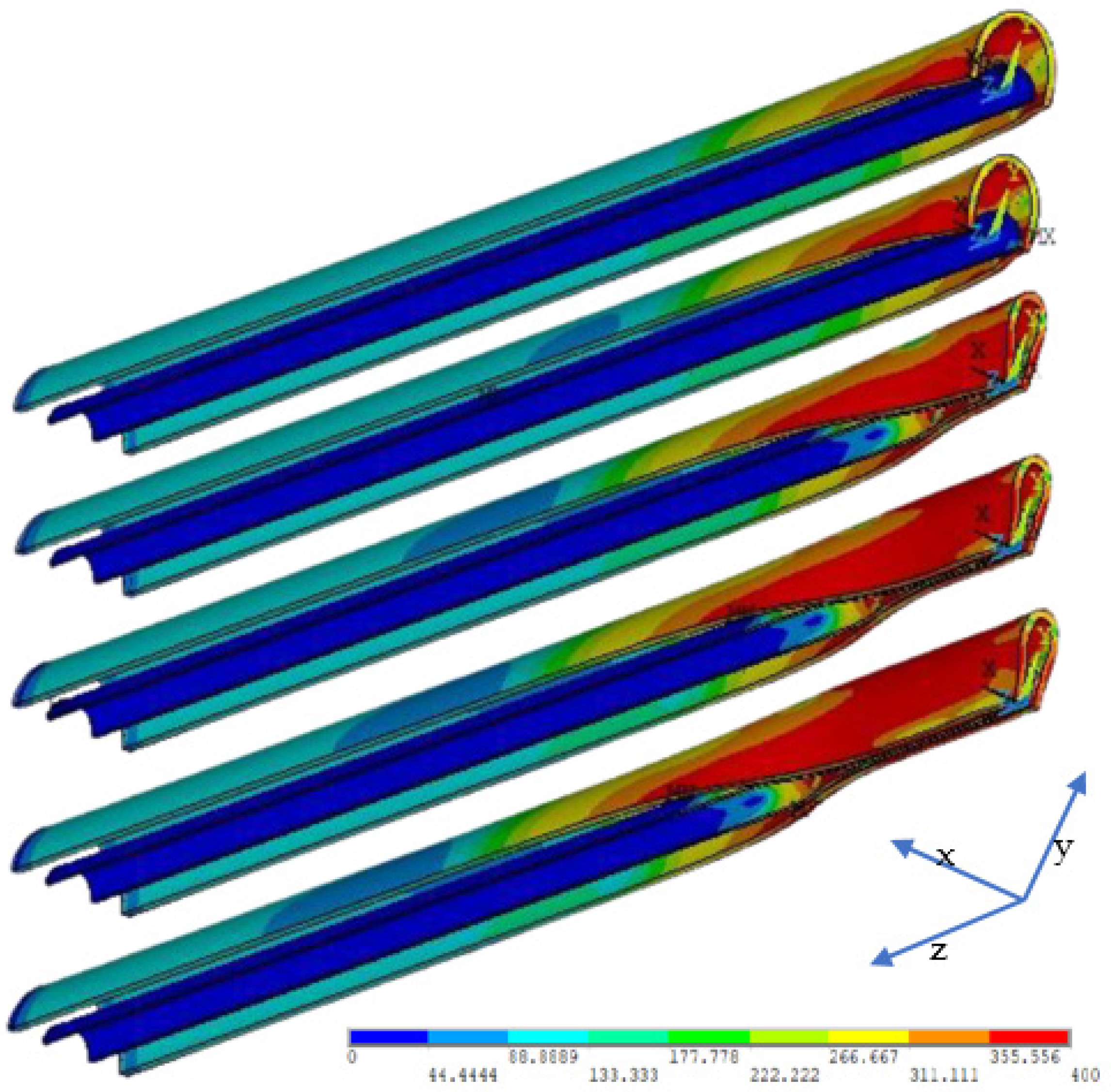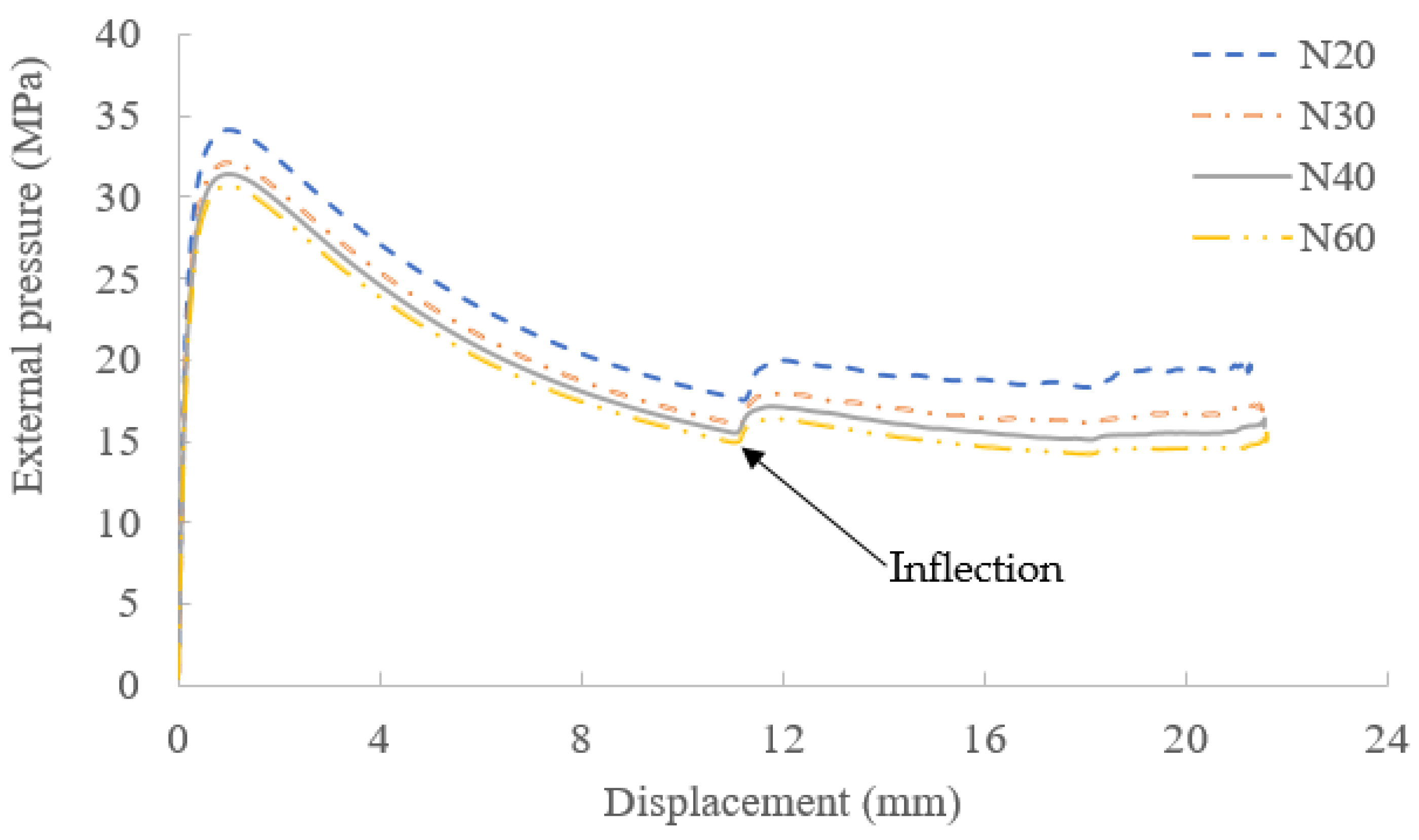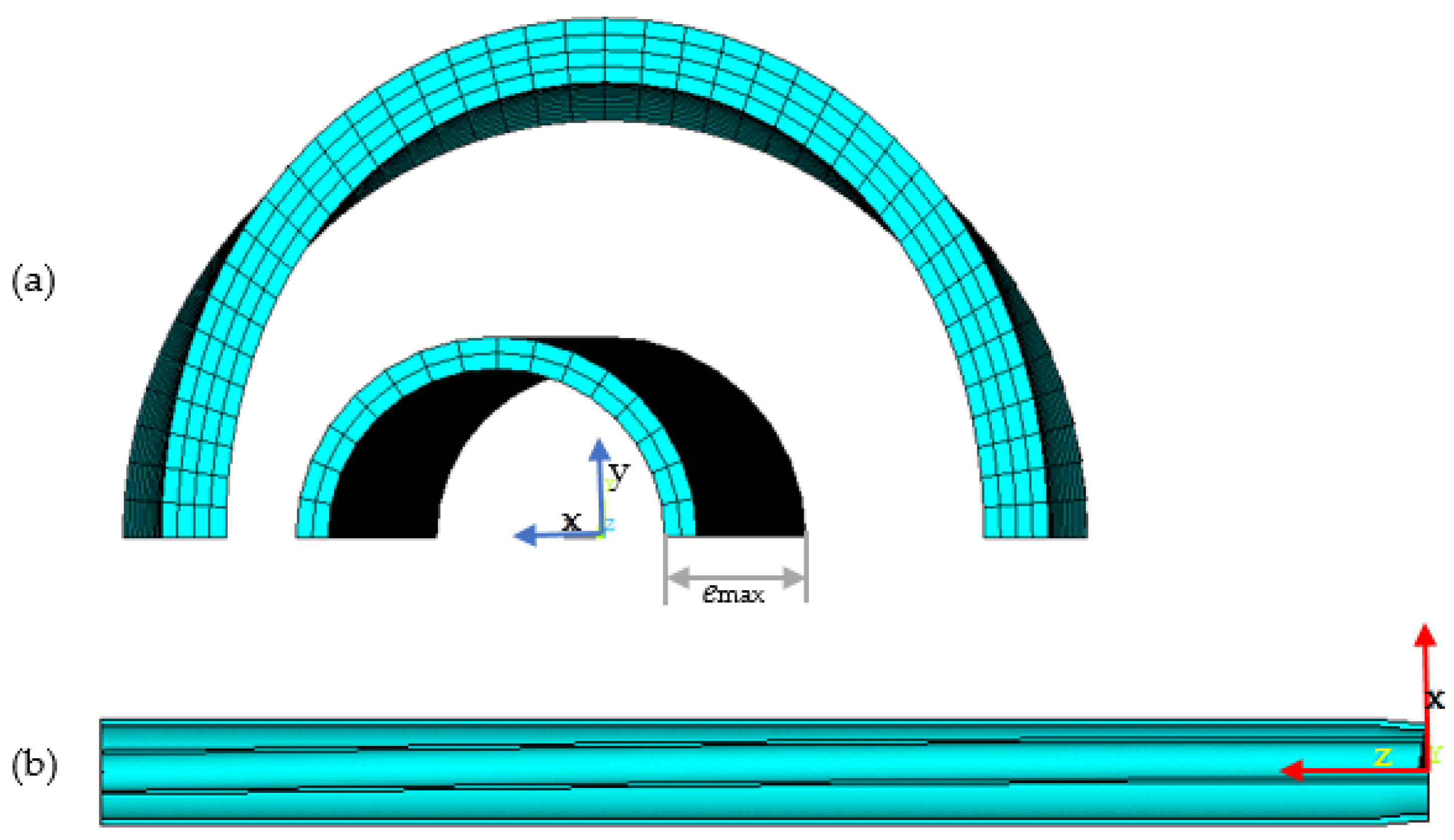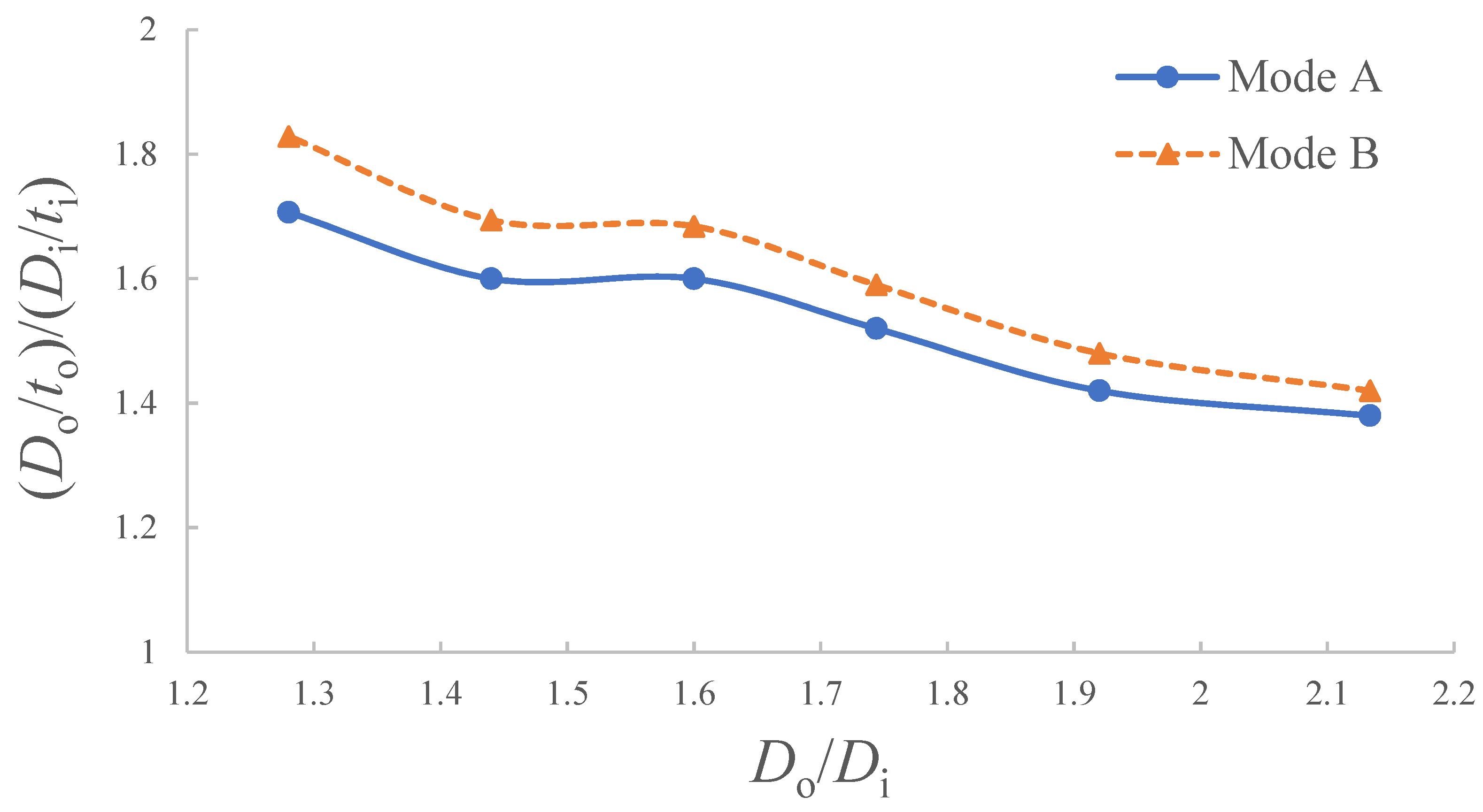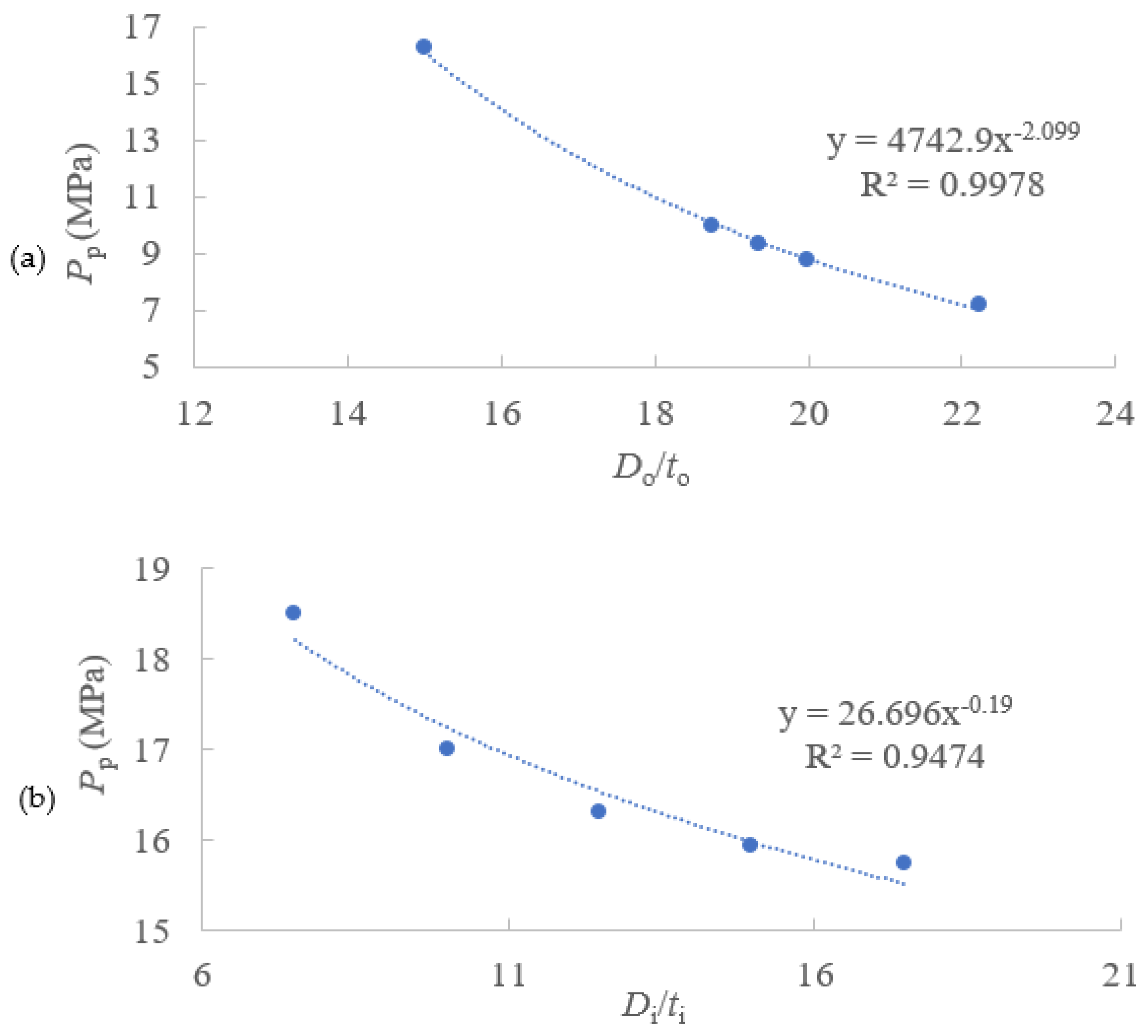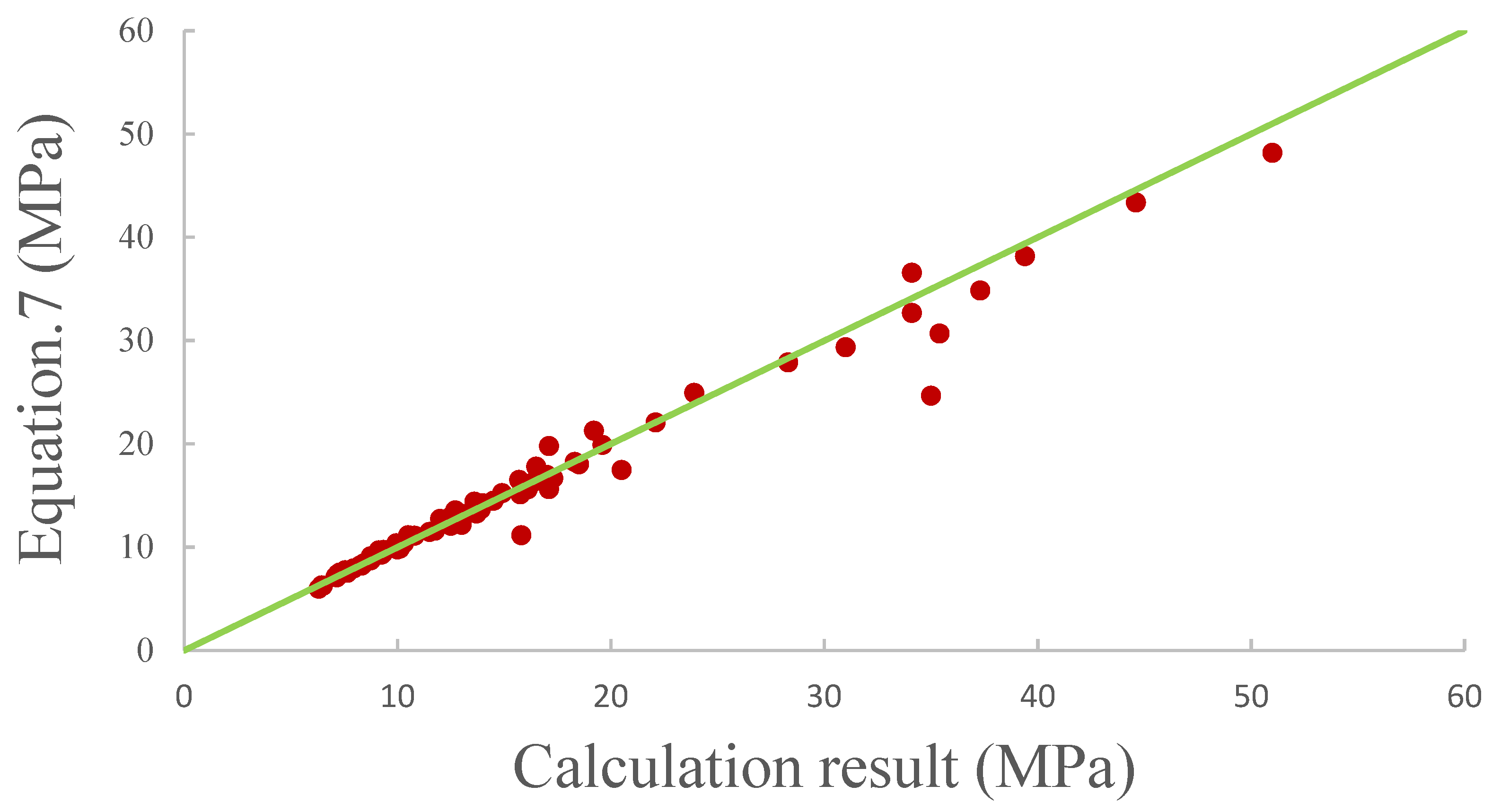1. Introduction
With the development of the offshore oil and gas industry, the deep-sea area becomes more and more important and valuable. As they constitute the main transmission unit, pipelines are required to be stronger to withstand higher water pressure. In an early work on the analytical solution of the collapse pressure of a single-walled pipe under external pressure, the significant influence of the ovality of the pipe cross-section was highlighted [
1]. The pressure-carrying capacity is dependent on the
D/
t ratio of pipes under pure external pressure [
2,
3,
4,
5,
6].
For subsea pipelines settled on the seabed with great water depth, thermal protection is still a task to be solved. Since the transmission distance of the pipeline system is up to several kilometres, the decrease in temperature will slow down the flow of the fluid, and even stop it. To avoid possible economic loss and environmental pollution in the aforementioned situation, pipe-in-pipe (PIP) systems are designed. The PIP contains two pipes: the outer pipe responsible for tolerating the hydrostatic pressure due to the subsea environment, and the inner pipe responsible for carrying the fluid gas or oil at high temperatures. Between the outer and inner pipes, the gap is expected to slow down the temperature dissipation of the fluid during the transmission over a long distance.
Alrsai et al. [
7,
8] figured out that the ultimate collapse strength of PIP is equal to that of a single-walled pipe with the same geometrical features as the outer pipe under external pressure. Generally, the two pipes of the PIP system are not very close to each other. Before the ultimate buckling state of the outer pipe, contact between the two pipes does not occur. Bhardwaj et al. [
9] showed the uncertainty of the research of the PIP system.
In real engineering applications, the initial imperfection is always introduced onto the pipes during manufacture and installation procedures. When the pipes are subjected to external pressure, failure first occurs in the cross-section with the most severe initial imperfection, and then the buckle spreads rapidly along the axial direction [
10]. Thus, in addition to the ultimate collapse strength of pipelines, the buckle propagation pressure (
Pp) is considered another key characteristic.
In general, the buckle propagation pressure is lower than the ultimate collapse strength. It is worth determining the value of the buckle propagation pressure. Netto and Estefen [
10] performed experimental tests on the buckle propagation of single-walled pipes. Then, the dynamic propagation phenomenon and the formation of flip-flop was introduced by Lee et al. [
11].
Based on the proposed buckle deformation mode for single-walled pipes [
12], the analytical solutions of
Pp are derived.
Figure 1 shows the buckle propagation mode of the pipeline in the 2D scenario. Based on that, Kyriakides and Vogler [
13] investigated the buckle propagation phenomenon in the PIP system. The cross-section of the pipeline contains four plastic hinges for each pipe, as shown in
Figure 1a,b.
The buckle propagation pressure of single-walled pipe proposed by Kyriakides et al. [
12] is,
where,
σ0 is the yield stress,
t is the thickness of the pipe,
D is the diameter of the pipe.
The buckle propagation pressure of PIP proposed by [
13] is,
where,
σ0i is the yield stress of the inner pipe,
ti is the thickness of the inner pipe.
Wierzbicki and Bhat [
14] applied the balance of the internal and external energy in the derivation of the buckle propagation pressure. The internal energy is contributed to by eight plastic hinges as shown in
Figure 1c. External energy is the work of the hydrostatic external pressure. The buckle propagation pressure is as follows:
where,
E is Young’s modulus of the pipe.
Alrsai et al. [
7] found two different buckle propagation modes in the numerical simulation of their study on a PIP system:
Mode A: The buckle propagation occurs after the contact between the upper and lower parts of the inner surface of the inner pipe;
Mode B: During buckle propagation, the inner surface of the inner pipe maintains a distance away from contact.
The difference between these two modes is illustrated in
Figure 2. It was also concluded that the buckle propagation mode changes from Mode A to Mode B when the geometrical parameters satisfy the relationship of
Do/
to = 1.25
Di/
ti [
7].
Similar phenomena were also illustrated by Gong and Li [
15]. They classified buckle propagation into four modes, which could be also summarised into two modes according to the criteria of Mode A and B from [
7]. The research investigated the buckle propagation pressure experimentally and numerically, while empirical equations were derived.
In the previous research, the dominant factor influencing the buckle propagation mode is assumed to have a constant value. Moreover, in the parameter studies, the variables are considered to affect separately the carrying capacity of the PIP system, lacking the coupling effect between them.
Aiming at providing an efficient approach for the evaluation of the buckle propagation pressure in a PIP system, the current research performed a numerical study with the help of the finite element method. At first, the numerical simulation in ANSYS was verified by comparing the results with those from the model experiment in [
14] in 3D scenarios. Then, the influence of several kinds of initial imperfection was checked. Third, the effects of the geometrical parameters of both inner and outer pipes were studied. Fourth, a critical parameter used for figuring out the buckle propagation mode was proposed. Finally, a semi-empirical formula was derived to express the buckle propagation pressure with the geometrical parameters of the PIP system.
2. FEM Validation
In this section, the validity of the numerical simulation is verified. The results from the finite element analyses in ANSYS are compared with those from the experiments performed in [
15]. Then, the mesh sensitivity is checked by four models with different mesh divisions but with the same scantling.
2.1. Validation with Model Experiment
In model experiments, steel grade SS316 is applied [
15]. The geometrical parameter and physical properties of the pipe are shown in
Table 1. The ultimate collapse strength and buckle propagation pressure obtained in the model experiment were 29.54 MPa and 14.98 MPa, respectively.
In this research, finite element analyses were performed with the help of ANSYS using the Solid element SOLID185. One case, entitled N40, was analysed to be verified against the model experiment, of which the mesh division is shown in
Table 2. The strain-stress curve of the steel shown in
Figure 3 is considered in the current analyses.
Due to the symmetricity of the structure, only a quarter of the PIP is modelled, with half of the cross-section and half of the length, as shown in
Figure 4. The geometrical parameters are identical to those in the model experiment (as shown in
Table 1). The initial ovality is introduced only onto the outer pipe which locates in the middle span of the pipe. The total length area of this initial ovality is 60 mm which is equal to the diameter of the outer pipe. The introduction of the above-mentioned initial ovality is realized by changing the nodes’ coordinates according to
The definition of ovality is as follows:
An initial ovality of 7.85% is introduced into Case N40.
Contacts are defined between the inner surface of the outer pipe and the outer surface of the inner pipe, as well as the self-contact of the inner surface of the inner pipe. The fixed boundary condition is applied on nodes at z = 750. The external pressure is applied on the outer surface of the outer pipe.
The deformation and von Mises stress distribution during the buckle propagation procedure are shown in
Figure 5 and
Figure 6, respectively. In such a dynamic procedure, five states are displayed in both figures. In the first state, local buckling occurs in the middle of the pipe where the initial ovality is introduced. After the second state when the outer pipe contacts the inner pipe, self-contact of the inner pipe is observed in the third state. Then in the last two states, the buckle propagates along the axial direction of the PIP system.
The ultimate collapse pressure and buckle propagation pressures are 31.39 MPa and 16.30 MPa, respectively. After comparing with the results obtained from the model experiment, the errors are 6.27% and 8.81%, respectively, which indicates an acceptable accuracy provided by the finite element model. Thus, in the following numerical simulation of this research, similar parameter settings were adapted.
2.2. Effect of Mesh Sensitivity
To figure out the mesh division with good computing efficiency and simultaneously acceptable accuracy, four cases are further calculated. Considering the geometrical parameters shown in
Table 1, different mesh divisions are presented in the new finite element models, as shown in
Figure 7.
The details of element number and size in the four models are listed in
Table 2. These four cases are in the N-series named by the mesh number of the outer pipe in the circumferential direction. The comparison between the results obtained from the N-series cases and the experiments is listed in
Table 3. The result of the external pressure with respect to the displacement in the cross-sections of the models is shown in
Figure 8. The displacement of the cross-section is represented by the displacement in the
x-direction of the node belonging to the outer surface of the outer pipe with the maximum initial ovality as shown in
Figure 7.
An inflexion exists in the curves in
Figure 8 when the displacement is approximately 11 mm. At this moment, the contact between the outer and the inner pipes occurs. Consequently, the carrying capacity of PIP starts to increase because the inner pipe starts to participate in the resistance to structural deformation.
Despite the fact that Case N60 has the minimum errors compared with the experiment, the large element number of Case N60 indicates a great computational effort required. Case N40 utilizes 1/3 elements of those used in N60 but obtains similar accuracy. Thus, in the following calculations, the mesh division of Case N40 is applied.
Moreover, in terms of the initial dent area, the length is set to be 60 mm in the following cases.
4. Effect of the Geometry of the Inner Pipe
When checking the influence of the initial imperfection of the inner pipe in the previous section, the geometrical parameters of the inner pipe varied. In this section, the names of cases are defined as ‘
Do-
to-
Di-
ti’. For instance, the name of the case in the first line of
Table 6 is ‘60-4-10-2’.
In this section, besides Case ‘60-4-25-2’ (N40), five more ratios of
Di/
ti are selected. Five cases with a constant
Di of 25 mm and another five cases with the same
ti as 2 mm are shown in
Table 7. The ultimate collapse strength of PIP equals that of the outer pipe. Thus, because the outer pipes of cases listed in
Table 7 share the same geometrical parameters, the ultimate collapse strength is not presented.
From the listed results in
Table 7, it is noticed in Case ‘60-4-15-2’ and Case ‘60-4-25-3.33’, in which the value of the ratio (
Do/
to)/(
Di/
ti) is equal to 2 in both cases, the buckle propagation mode is different. It is supposed that the buckle propagation mode is influenced by the ratio of (
Do/
to)/(
Di/
ti), but the ratio is not a fixed value.
7. Buckle Propagation Pressure of a PIP System
In the process of pointing out the boundary between two buckle propagation modes, a large number of numerical simulation cases was created and calculated. In this section, the buckle propagation pressure of the PIP system is studied. Both Alrsai et al. [
7] and Gong and Li [
15] derived empirical equations of buckle propagation pressure. Both equations are made up of a combination of separated parameters together. Based on the results of the present research, the semi-empirical formula is derived to describe the relationship between buckle propagation pressure and the geometrical parameters of the PIP system.
Both effects of the ratio
Do/
to and
Di/
ti were investigated. For the case with diameters of the outer and inner pipes as 60 mm and 25 mm, respectively, the buckle propagation pressure is shown in
Table 11.
The relationship between the buckle propagation pressure and the
D/
t ratios of outer and inner pipes are illustrated in
Figure 12, in which both trendlines are in the style of power functions. So, it is assumed that the buckle propagation pressure can be expressed by the following:
where,
χ,
α and
β are related to the ratio of
Do/
Di, and will be explained later in this section.
To determine the expression of
χ,
α, and
β, several new cases listed in
Table 12 were analysed. The ratios of
Do/
to and
Di/
ti are in the ranges of 10 to 33 and 7 to 50, respectively. The ratio of
Do/
Di is in the range of 1.28 to 3.2. As pointed out in the last case in
Table 11, the buckle propagation pressure did not increase to a large extent when the thickness of the inner pipe changed from 3.33 mm to 5 mm. The same phenomenon is also found in other series of calculations. So, the results of these cases are excluded from the summary.
After summarizing the results of 73 cases, the expression of
χ,
α, and
β can be expressed as follows:
The comparison between the calculation results and the results predicted by Equation (7) are shown in
Figure 13, which leads to the conclusion that a good agreement is achieved.


